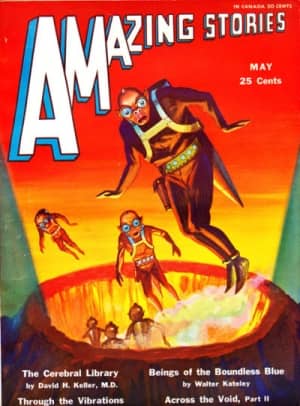Birthday Reviews: Lloyd Arthur Eshbach’s “The Valley of Titans”

Lloyd Arthur Eshbach was born on June 20, 1910 and died on October 29, 2003.
Eshbach founded Fantasy Press in 1946 and ran it for 9 years, publishing nearly fifty books, including titles by Doc Smith, Stanley Weinbaum, Jack Williamson, A.E. van Vogt, Robert A. Heinlein, L. Sprague de Camp, and others.
Eshbach’s novel The Land Beyond the Gate was nominated for the Compton Crook Stephen Tall Memorial Award. In 1988, he received the Milford Award for Lifetime Achievement, the Gallun Award for contributions to science fiction, and the First Fandom Hall of Fame Award. In 1949, he was the pro Guest of Honor at the Cinvention, the 1949 Worldcon in Cincinnati and in 1995, he was the Publisher Guest of Honor at the World Fantasy Convention.
Originally published as by “L.A. Eshbach,” “The Valley of Titans” originally appeared in the March 1931 issue of Amazing Stories, edited by T. O’Conor Sloane. It was Eshbach’s fourth published story. Interestingly, underneath his byline, the magazine touted him as “Author of ‘A Voice from the Ether’,” which wouldn’t appear until the May issue of the magazine. In 1968, Ralph Adris reprinted the story in the March issue of Science Fiction Classics.
“The Valley of Titans” is less a story and more a travelogue. Eshbach’s narrator, James Newton, has been sent to fly over the Himalayas to discover what has happened to several missing airplanes. His own plane is forced down in an horrific storm and he discovers a lost valley high in the mountains. This valley has less in common with the Himalayan Shangri-La (and actually pre-dates Hilton’s novel by two years) and more in common with the Plateau of Arthur Conan Doyle’s The Lost World.
Newton is attacked by indigenous people who he believes are a more primitive form of human before he is rescued by Verne Carcante, a Scotsman living alone in the valley who is trying to figure out how to speed up human evolution. Unfortunately, all his experiments have reversed the process and he reveals to Newton that the ape-like creatures that attacked him were the passengers and pilots of the missing airliners, that Carcante had snatched from the sky. He offers to make Newton his assistant, but Newton manages to escape through the tunnels under the valley, where he finds Claire Maynard, one of the passengers who escaped Carcante’s treatment.
The couple discover a race of aliens who agree to help them get back to the surface and, if necessary, act against Carcante. At the same time, their leader infuses Newton and Claire with love for each other. By the time the aliens help the couple to the valley, the creatures Carcante has created have killed him, but as Newton and Claire work their way to his airplane, they are attacked and Claire is taken captive. Newton’s attempts to rescue her, riding into combat on a triceratops against stegosaurus mounted beastmen, is really the only action Newton takes in the entire story of his own volition.
Eshbach’s story is very much a product of its time. The characters exhibit casual racism and sexism which go unexamined. Eshbach’s descriptions play to the stereotypical science fiction story in which the author describes the minutiae of how instruments and technology work. The villain has little depth and while the setting is taken from Arthur Conan Doyle, the relationship between Carcante and the beastmen seem more akin to H.G. Wells’s The Island of Doctor Moreau.
Reviewed in its original publication in the magazine Amazing Stories, edited by T. O’Conor Sloane, March 1931.
 Steven H Silver is a sixteen-time Hugo Award nominee and was the publisher of the Hugo-nominated fanzine Argentus as well as the editor and publisher of ISFiC Press for 8 years. He has also edited books for DAW and NESFA Press. He began publishing short fiction in 2008 and his most recently published story is “Doing Business at Hodputt’s Emporium” in Galaxy’s Edge. Steven has chaired the first Midwest Construction, Windycon three times, and the SFWA Nebula Conference 6 times, as well as serving as the Event Coordinator for SFWA. He was programming chair for Chicon 2000 and Vice Chair of Chicon 7. He has been the news editor for SF Site since 2002.
Steven H Silver is a sixteen-time Hugo Award nominee and was the publisher of the Hugo-nominated fanzine Argentus as well as the editor and publisher of ISFiC Press for 8 years. He has also edited books for DAW and NESFA Press. He began publishing short fiction in 2008 and his most recently published story is “Doing Business at Hodputt’s Emporium” in Galaxy’s Edge. Steven has chaired the first Midwest Construction, Windycon three times, and the SFWA Nebula Conference 6 times, as well as serving as the Event Coordinator for SFWA. He was programming chair for Chicon 2000 and Vice Chair of Chicon 7. He has been the news editor for SF Site since 2002.
Today’s snubs — Stanley Mullen (a slightly later pulpster) and Pamela Zoline, a far superior writer, but not terribly prolific.
Never heard of ’em. Read a couple cool Eshbach tales, though!